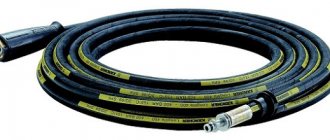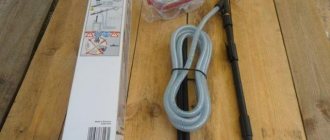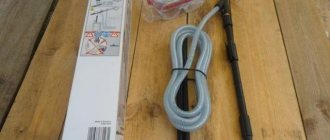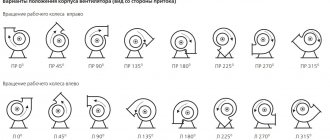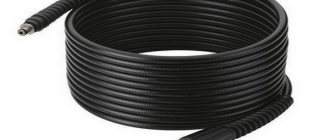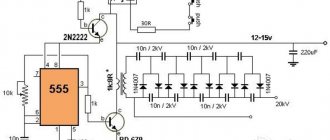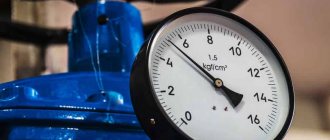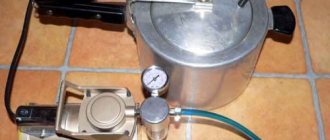Features of high pressure hose repair
High-pressure hoses, more often called high-pressure hoses (HHP), are designed to create or absorb working force, which is transmitted under high pressure by liquids or gases pumped into them.
High pressure hose
The main area of application of RVDs is hydraulic and pneumatic systems of various devices and mechanisms. Outside of industrial production, vehicle owners most often deal with high pressure hoses, these are power steering hoses, and those who use high-pressure pumps, for example, our most common brand, Karcher.
Serge-gres › Blog › Repair of high pressure hose Karcher 5.20
A friend of mine asked me for a high-pressure hose to wash his car; he accidentally damaged his own by running over the car, so I gave the hose without a second thought, and a couple of days later he reported that the hose was being torn off from the car wash and he didn’t use it.
It turned out that his sink was not a Karcher, but either a Huter or a Bison. Having examined the hose and noticing the broken thread on the plastic cap nut, I realized that the hose had been forcibly shoved into place where it didn’t fit. After scouring the Internet, I chose the most optimal way to restore the union nut by completely replacing it. It took me an hour to do everything in the garage. First of all, using a vice and a hacksaw, I cut the plastic nut off the hose.
Next, I purchased a Kamaz wheel nut and sawed off the clamping skirt from it.
You need to get rid of the skirt because: 1. it does not fit into the hole on the sink body 2. it increases the length of the nut. The next step was to purchase a washer with an internal hole diameter of 13mm (after cutting the diameter will be reduced) and also sawed it in half with a hacksaw.
Now I was able to try it all on the hose.
At this stage, I realized that the nut should be fastened exactly as in the photo, with the protrusions forward. The fact is that the threaded part on the sink fitting is limited and if the nut is assembled with the other side, the length of the thread on the fitting will not be enough to tightly connect the fittings. Now I boldly began welding work, but first removed the rubber seal from the fitting on the hose and protected the hose itself from the temperature (have a bottle of water nearby). I used tacks to connect the washer to the hose and then centered the washer and nut and welded everything together.
Having returned the seal to the hose fitting, lubricated the threads of the nut with grease using a 32mm wrench, I screwed the hose to the sink.
Source
RVD structure
The design of the RVD is determined by the need to withstand internal pressure, which can reach several hundred atmospheres.
In addition, the inner surface of the high-pressure hose must be impervious to the effects of the transported medium. Therefore, its bottom layer is made of oil- and petrol-resistant rubber or synthetic rubber.
To make the upper, thicker layer of the high-pressure hose, wear-resistant rubber is used, which, if necessary, is supplemented with thermal protection in the form of a corrugated coating, metal or polymer.
Between the upper and lower layers of rubber, metal wire is wound in several layers, thanks to which the hose receives the necessary rigidity and strength. Layers of wire are interspersed with thin rubber films.
Depending on the method of winding the wire, there are two types of high-pressure hoses:
- Winding. When producing this type of hose, turns of wire are wound in even rows.
- Braided. In this case, the turns are wound at an angle to the axis of the hose so that the turns of the previous layer intersect with the turns of the next layer of wire. Braided hoses have greater strength and can withstand greater pressure than coiled hoses.
High pressure hose
In addition to wire, textiles can act as an internal rigid frame.
The number of layers of wire and the thickness of rubber layers are set by standards that determine the scope of application of a particular type of hose.
Design and functional purpose of RVD
The Karcher high-pressure hose is one of the basic elements of the hydraulic system of washing equipment. The flexible pipeline is designed to supply water under pressure from the built-in pump to the nozzle of the device. To ensure that hoses can easily withstand significant loads, reliable, wear-resistant materials are used for their production. The design of the RVD consists of two layers of polymer - it can be either rubber or synthetic rubber. Between the inner and outer parts of the pipeline there is a metal braid, which gives the product additional strength. There are two types of wire winding techniques, which became the basis for the classification of pressure hoses:
- — Braided. The braid is applied at an angle, each subsequent layer is crossed with the turns of the previous one. Such hoses are designed for significant pressure levels.
- — Winding ones. Layers of wire are applied in even rows. In terms of endurance, high-pressure hoses of this type are inferior to the previous type of high-pressure hoses.
The market offers a wide range of hoses, differing in rubber thickness, number of braiding layers, diameter, length and permissible load - the parameters depend on the application of the products. When choosing high-pressure pipes for Karcher, you should follow the manufacturer's recommendations.
Fittings for high pressure hoses
To secure the hoses in place, fittings (tips) are mounted at their ends, which are of the following types:
- Screw;
- Union;
- Nipple;
- Quick connect connections.
Fittings are attached to the ends of the hose using crimp couplings, which are crimped on special machines.
Depending on the type of shank, fittings are classified into series:
- Universal. This series can be used in all hoses of high pressure hoses with the exception of coiled type hoses.
- Interlock. The series is used for coiled hoses.
When installing fittings of this type, it is necessary to remove both layers of rubber, internal and external.
Fittings for high pressure hoses
The operation of removing layers of rubber is called hose debarking.
- CS. Fittings of this series also crimp coiled hoses, but there is no need to remove the rubber of the upper and lower layers.
Failure of fittings is the most common cause of damage to high pressure hoses. This is explained by the magnitude and intensity of the loads they experience.
Damage to high pressure hoses
The causes of damage can be divided into the following types:
Important! In order to protect yourself as much as possible from possible damage to hose hoses, when choosing them, it is necessary to carefully check the compliance of their characteristics and parameters with operating conditions.
High pressure hoses with fittings
Causes of damage to the high pressure hose
Malfunctions of Karcher high-pressure washers are often associated with damage to the flexible pipe. The hose wears out, wears out, cracks form on it - as a result, a leak occurs. It should be understood that under the influence of significant pressure, the risk of tube damage increases. Another common malfunction is a violation of the integrity of fittings in Karcher sinks. Fasteners lose their tightness or become corroded. The causes of damage to the high pressure hose are of the following types:
- - Manufacturing defects. The use of outdated equipment, non-compliance with technology, lack of product quality control are the main reasons why hoses with various defects are found on sale.
- — Parameter mismatch. An incorrectly selected high-pressure hose will quickly fail.
- — Intensive operation. With prolonged use, under the influence of constant liquid pressure, the hose loses its initial properties.
The service life of the hose depends both on the quality of the pipeline itself and on the reliability of the fasteners. If you notice a fluid leak or a malfunction in the washer, you should clearly identify the location where the fitting or hose is damaged. If you have problems at the diagnostic stage, contact a professional. Our technicians will be happy to assist you in troubleshooting Karcher washing equipment.
Replacing damaged high pressure hoses
From all of the above, we can conclude that the repair of high pressure hoses consists of either replacing the damaged area or replacing fittings that have become unusable.
When replacing a damaged area, as well as when replacing fittings, you will need to crimp the couplings, that is, technologically these two actions are very similar.
High pressure hoses
The sequence of operations looks like this:
- The damaged sleeve is disconnected from the main mechanism.
- A new sleeve is cut to the size of the old one on a cutting machine. Moreover, for measurement, the distance between the ends of the nipples at its ends is taken. It is better to choose a hose pump designed for a higher pressure than that for which the old hose pump was designed.
- The markings on the sleeves will help you choose the right diameter.
The factory marking DN indicates the diameter of the internal channel of the hose.
If a non-standard connection is encountered, repairs are carried out using a repair fitting. To do this, take the head of the old fitting, to which the part to be crimped is soldered.
High-pressure hoses
This method is often used by car enthusiasts for emergency repairs of power steering hoses, as well as by owners of Kircher pumps and miniwashes.
DIY power steering high pressure hose repair
For these purposes, special systems equipped with fans are used. Various pumps and fans are a do-it-yourself crimping machine for stabilizing the temperature process in production. Special machines control the consumption of electrical energy and absorb the noise effect.
Any retail enterprise that sells food products uses scales. Modern scales are an automatic device that accurately measures the weight of goods. The device is equipped with a display, as well as a special keyboard, due to which the Sungarden T 240 cultivator attachment determines and displays the necessary information for the seller and the client. The scales can be powered by an electrical outlet or charged from a battery (portable version).
In any office or enterprise, with the help of special devices, optimal air temperature and air exchange are maintained. This is necessary to organize a comfortable work process. Among the types of appliances used are Cherepovets laundry equipment: hoods, air conditioners of various modifications, ventilation shafts with natural and artificial cooling. Ventilation can be exhaust, supply and mechanical.
Repair and replacement of power steering hoses
The reason for damage to power steering hoses is most often that when the steering wheel rotates due to friction, a serious force is generated. This force causes deformation of the elastic element, which changes the size of the holes in the distribution mechanism that regulates the pressure drop in the hydraulic cylinder.
As a result, the power steering sleeve connected to the limit valve wears out. This power steering sleeve is designed for pressure, depending on the make of the car, from 70 to 130 kgf/cm2.
At such high pressure, repairing a damaged power steering hose using clamps or wire is almost impossible.
There are two options left: either replace the entire power steering tube, or replace only the damaged part of it, replacing the fittings with a new hose.
Moreover, it is better to rearrange the fittings in a special workshop.
Replacement and installation of the power steering hose is carried out as follows:
- The front of the car is raised on jacks.
- The steering wheel is turned all the way to the left.
- Using a syringe with a tube attached to a needle, fluid is pumped out of the power steering reservoir.
- After this, the hose is disconnected, and the working holes of the hydraulic system are closed with plugs.
Power steering hoses
The selection of a new hose is made with exact observance of the diameter, otherwise the performance qualities of the power steering may change.
What is a crimp coupling?
Crimp coupling (sleeve, sleeve, ring) is a compression fitting designed for mounting end fittings on a high-pressure hose (HPR). The coupling is an integral part of all types of RVD end fittings, solving several problems:
- Mechanical fixation of the end fittings on the hose, ensuring its normal functioning at high pressure;
- Protection of the end part of the hose from ruptures and deformations;
- Due to its rigidity, it protects the end parts of the hose from bending when installed with bends.
With the help of crimp couplings, a permanent connection of the hose hose with fittings is ensured; they are used in piece and serial production of high-pressure hoses (hoses) for hydraulic systems of various types and purposes.
Types and designs of crimp couplings
RVD end fittings - coupling and nipple with nut
Connecting a high-pressure hose with an end fitting
Structurally, all couplings are the same - it is a short steel tube (bushing), at one end of which there is a collar directed inward to rest against the end of the hose. The outer surface of the couplings is smooth; on one edge there may be markings in the form of one or more annular grooves, a narrowing of the diameter or hatching. Also, alphanumeric markings can be applied to the coupling.
Crimp couplings are divided into several types according to their applicability and the structure of the internal surface.
There are two main types of couplings:
Lightweight couplings have a small wall thickness; they are designed for mounting end fittings on hose hoses of types 1 ST/SN and 2 ST/SN (with one and two braids). Reinforced couplings are designed for use with hose hoses of types 4 SP/SH, R12 and R13 (with four and six braids) and others.
In this case, crimp couplings are divided into two groups according to the method of installation on the hose:
Stripping couplings require stripping (barking) of the outer and/or inner layer of the hose for installation; they come into direct contact with the outer wire braid. Non-stripping couplings can be mounted directly on the hose without removing the outer layer; couplings for plastic and metal-plastic pipes also belong to this type.
Selection and correct use of crimp couplings
The choice of crimp couplings must be made based on the type of high-pressure hoses, their characteristics, dimensions and purpose. For hose hoses of types 1 ST/SN and 2 ST/SN, lightweight couplings are suitable; to work with hose hoses of types 4 SP/SH, R12 and R13, it is necessary to use reinforced couplings. In most cases, it is sufficient to use universal couplings, although in the manufacture of some pipelines, end fittings with specially designed couplings may be required.
Corrugated couplings are best suited for rubber hose hoses, which ensure the most reliable installation during longitudinal crimping. Smooth couplings are used for transverse crimping, during which annular grooves are formed on the coupling. Smooth couplings are also used to work with many types of plastic pipelines.
When choosing couplings, special attention should be paid to the technology of their installation, namely, whether it requires stripping the hose or not. If the coupling is stripping, then the hose must first be prepared - remove the outer and/or inner rubber layer; if the coupling is not stripped, then installation can be performed without pre-processing the sleeve. Installation of stripping couplings on an unstripped hose is prohibited, as this reduces the reliability of the hose and end fittings. This rule is also relevant for non-stripped couplings - it is not recommended to install them on a stripped hose.
Crimping of high-pressure hoses is carried out using special presses. If the work is carried out using stripping couplings, then you also need to have a debarking machine to remove the top and/or inner layer of the hose. If crimping is performed correctly, the high-pressure hose and its end fittings will meet the requirements of GOST; such products will ensure reliable operation of hydraulic and other systems in any conditions.
How to independently carry out repair work to restore the high pressure hose?
It is not difficult to properly repair a hose, ensuring stable and long-term operation of the washer; the main thing is to strictly follow the recommendations, perform all actions carefully and carefully. Regardless of the nature of the damage, the RVD should initially be removed. The hoses are attached to the equipment using a thread or a quick connector - this depends on the machine model.
The next steps are as follows:
- 1. After dismantling the tube, cut off the damaged part to the point where there is no deformation.
- 2. If the hose is damaged at the end or the fastener is broken, select a similar fitting and crimp it using a vice.
- 3. When a cut has formed along the length of the hose, a connector of a given diameter, as well as two clamps, are used for repair. They help seal the joints of the sleeve. Similar work is carried out if it is necessary to lengthen the tube or connect two hoses.
What if the cracks run along the entire sleeve? In such a situation, it is rational to purchase and install a new tube. – the domestic manufacturer of hose hoses and end fittings for washing equipment Karcher will offer a high-quality alternative. Our specialists know exactly how to repair a hose or choose a worthy replacement for it. Clients can expect affordable prices for work, prompt execution of orders, and a responsible approach to solving assigned tasks.
Background
The Korbit tourist club has an equipment base. There is a well and a Karcher pressure washer. For three years this entire system worked without failure. And so, the Karcher hose broke. Many questions immediately arose. Where can I buy a new hose? Where to go if you need Karcher urgently?
